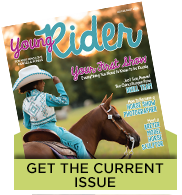Popping nicely over a big fence or cantering smoothly around a course isn’t something you learn overnight. Becoming a confident and capable jumper takes lots of practice and many hours spent in the saddle jumping lots of different types of fences.
Many of you have great trainers who set up challenging courses for you and who offer you advice during jumping lessons. But we know that not everyone is lucky enough to have regular tuition. That’s why we’ve come up with 10 tips to help you become a better jumper.
Always ask a pal or a parent to watch you when you jump. Never jump alone. Don’t jump fences that are too big or dangerous for you and your horse. And of course, always wear an approved safety helmet every time you ride. It seems like we all fall off a lot more when we start jumping, so it’s important to think about safety before you shorten your stirrups a hole or two and head for that first fence.
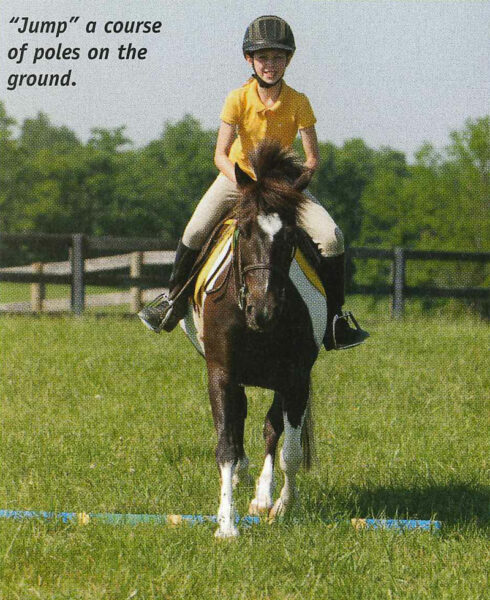
1. Pole work
You don’t even need fences to practice jumping; just four or five painted poles on the ground can help you fine tune your jumping skills. Set up poles as you would set up fences.
Set up two poles 24 feet apart to simulate a double. Set up three poles 24 feet apart to simulate a triple. If you can’t canter through these poles with the correct striding, maybe you shouldn’t be jumping fences yet!
You can also set up a whole “course” of poles. Trot and canter around the poles as if they were a real course.
Top Aussie eventer Clayton Fredericks won’t let his students pop a fence until they can canter their horses smoothly around a course of poles!
2. Grids
Set up a grid. Grids are a great way to sharpen up your horse’s jumping skills and help you work on your jumping position. If the fences are spaced correctly, the grid should be easy for your horse to jump.
Try this easy grid. Set up four cross-rail fences in a row. If you ride a horse, put a placing pole on the ground about nine feet in front of the first fence, and then each fence after it should be approximately 17-18 feet apart.
If you ride a pony, put a placing pole about eight feet in front of the first fence, then each fence should be about 14-15 feet apart.
All these distances are approximate. You may have to adjust them to suit your horse or pony.
Trot your horse into the grid and let him canter out. Aim for the middle of the poles. Get into jumping position right before the placing pole, grab mane and stay forward throughout the grid.
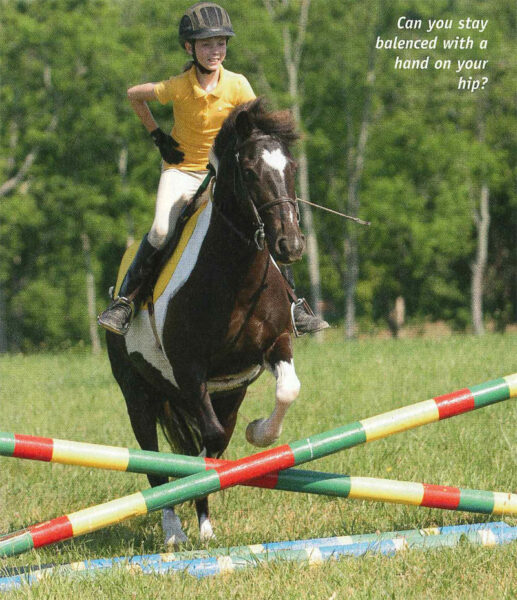
3. Jumping exercises
Set up a small cross-rail fence and then pop over a few times trying these exercises. Approach the fence while trotting. Don’t worry if your horse canters for a few strides after the fence.
Hold the reins in one hand and place the other hand on your hip as you head over the fence. This exercise teaches you how to stay balanced in the saddle and it prevents you from depending on your horse’s mouth for support. If you feel brave, knot your reins and try it with no hands!
See how balanced your upper body is by carrying a mug of water in it in one hand over a fence. If you spill most of the water, you need to be a little more “quiet” over a fence and not move around so much!
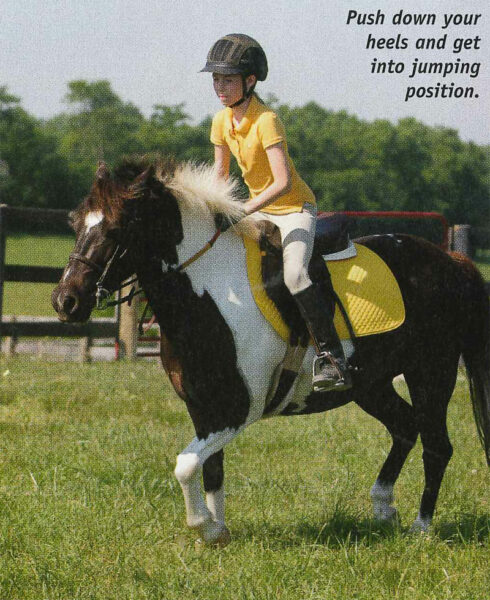
4. Lots of jumping position
Get up into jumping position whenever you can. Push down your heels and lean forward over your horse’s neck. Grab on to mane if you feel like you might get tired or lose your balance. Walk, trot and canter in jumping position. Get into jumping position when you’re trail riding or cooling down your horse after a lesson. Jumping position will make your legs stronger.
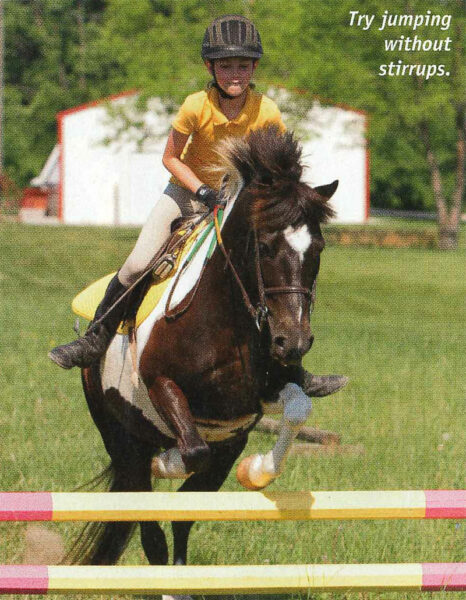
5. Drop your stirrups
Cross your stirrups and jump a small fence a few times at the trot and the canter with no stirrups! It will be hard to get into jumping position without stirrups, but you can do it. This exercise strengthens your legs.
Can you jump a whole course without stirrups? Try it!
6. Set up a skinny
Jumping narrow fences helps you improve your steering. Skinnies also teach your horse how to be bold and jump whatever you point him at.
Set up a skinny fence in your arena or field by placing jump standards on either side of a hay bale or a single barrel lying on its side.
Try a skinny fence at the trot first and concentrate on keeping your horse straight and moving forward.
Some horses may balk at jumping a skinny fence the first time, but most will realize that it’s easy after they pop over it a couple of times.
7. Cross-country jumping
If you’ve got access to cross-country jumps, get out of the arena and pop over a few natural-looking fences. Jumping over little logs and small walls is fun and cantering and jumping outside of the arena will build up your confidence. Your horse will be happy to get out of the ring too.
When jumping cross-country, sit back in the saddle a bit more and get into jumping position a tiny bit later than you would when you’re jumping in the arena. You may need your seat to help push your horse forward over a fence.
Grab hold of some mane in front of the fence in case your horse jumps big to prevent you from getting left behind.
8. Practice looking up
Lots of people look down or duck to one side when jumping a fence. Looking down and ducking can affect your balance which can make your horse jump badly.
Ask a barn pal to stand about 100 feet in front of a fence and as you approach the fence she should raise her hand and stick up one finger (or two, three, four or five!) If she put up two fingers, shout out “two fingers” so she knows you’re looking at her hand, not down at the jump.
Repeat this exercise a few times.
9. Take jumping lessons
It’s so important to take regular lessons with a good trainer. If you can afford it, try to take at least one jumping lesson a month. A trainer will work on your jumping position, and she can set up exercises you might not have tried yet. If you’re having jumping problems with your horse, a good trainer should help you work through the issues.
If you can’t afford a trainer or there isn’t one in your area, read horsey magazines to find jumping tips and exercises to help you out.
You can also study books like the United States Pony Club Manuals (www.ponyclub.org) or Jumping for Kids (www.storey.com) which are full of helpful jumping instruction. Ask your mom or dad to read these books too so they can be your ground crew when you jump.
10. Jump different horses
If you ride in a lesson program, ask to ride a different horse every once in a while. You can develop some bad habits when you ride the same horse all of the time. Switch ponies with a barn friend and pop over a few fences.
Riding different horses and ponies with varying jumping styles will make you a better rider.
This article originally appeared in the September/October 2009 issue of Young Rider magazine. Click here to subscribe!

